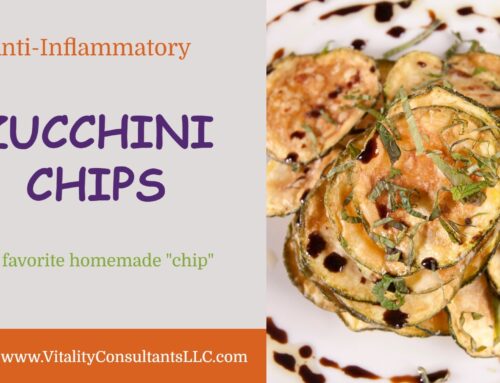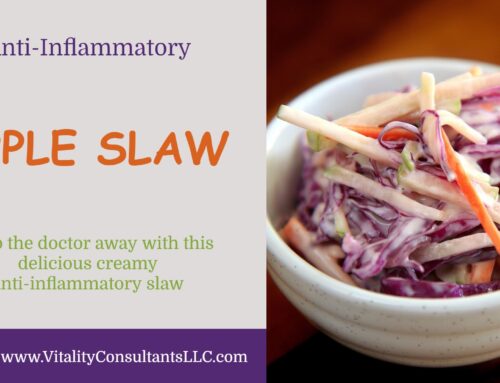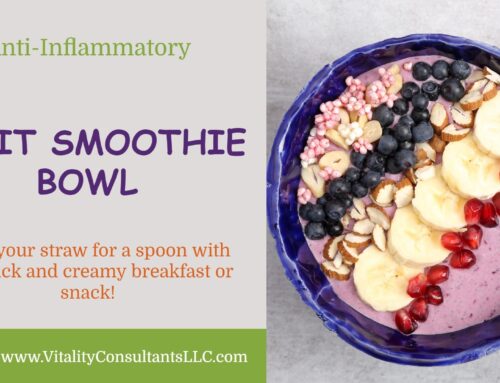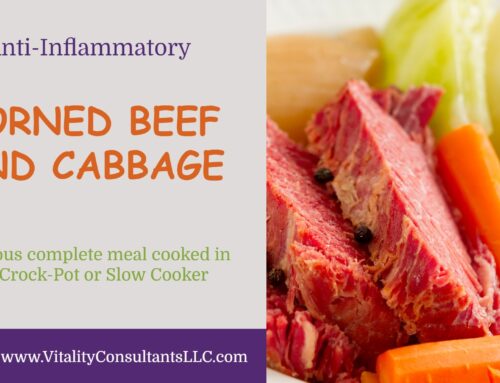by: Ali Brown, RD, LD
Are you looking for anti-inflammatory diet tips? Anyone starting an anti-inflammatory diet can tell you that it’s not easy work. Since we opened Vitality Consultants we have had a mission to help you reach your health goals in any way possible. Here’s a compilation of 52 anti-inflammatory diet tips we put together over the last year:
- Don’t let yourself get hungry. It’s no secret that we tend to make poor food decisions on an empty stomach. Eat regular meals and keep snacks on hand everywhere you are – almonds in your car, fruit on your desk, chopped veggies in your fridge, and pumpkin seeds in your bag. When you stay full on good, healthy food you are more likely to be successful.
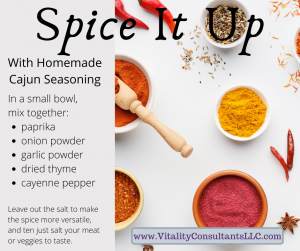 Spice up your life! Food tastes much better when seasoned properly. Not only that but adding new spices to meals will add some variety to dishes that may have been getting repetitive.
Spice up your life! Food tastes much better when seasoned properly. Not only that but adding new spices to meals will add some variety to dishes that may have been getting repetitive.- Never skip breakfast. Your mother always told you that breakfast is the most important meal of the day. Research has shown that people who eat breakfast tend to eat fewer calories and fat during the day than those who opt out of a morning meal. If you are rushed for time try making breakfast the night before check out our blog post on Best Healthy Breakfast Ideas for People on the Run. We also give you information on breakfast as well as recipes in our blog post, Anti-Inflammatory Breakfast Ideas.
- Try new recipes. There’s nothing better than finding a recipe you’ve never tried before! You can find thousands of anti-inflammatory recipes online. Try something new once a month to keep yourself excited to eat healthy food. We’ve included some delicious recipes at the bottom of this article.
- Make adaptations to menu items so they fit your meal requirements. We know that it’s impossible to eat every meal at home. Plan ahead and find substitutions that can be made so that going out doesn’t have to be a setback. Here are a few suggestions: – Take the bun and cheese off your sandwich and substitute broccoli for fries. – Order an “unwich” at Jimmy Johns – your favorite sub held together by a lettuce wrap instead of bread.
- Don’t let setbacks ruin your progress. Mistakes are inevitable. Our advice: get over it ASAP! Don’t let one bad meal or snack ruin an otherwise healthy day (or week). Get back on track and make your next meal count.
- Embrace variety. The worst diet mistake people make is falling into a strict routine. Chicken and vegetables for dinner every night can get old pretty quickly, which can make falling into old habits easy and tempting. Add variety to your diet by preparing your food different ways, trying new recipes, or experimenting with a piece of produce you’re unfamiliar with.
 Don’t focus on the numbers. When you are eating healthy you usually expect to lose weight – and most of the time you will. Don’t get caught up on the scale. Your weight can fluctuate for dozens of reasons, and you shouldn’t get discouraged because you’re at a plateau or gained a few pounds. The important part is how you feel. Since you’ve started this lifestyle you probably notice that you have more energy, less gastrointestinal irritation, and fewer allergy symptoms.
Don’t focus on the numbers. When you are eating healthy you usually expect to lose weight – and most of the time you will. Don’t get caught up on the scale. Your weight can fluctuate for dozens of reasons, and you shouldn’t get discouraged because you’re at a plateau or gained a few pounds. The important part is how you feel. Since you’ve started this lifestyle you probably notice that you have more energy, less gastrointestinal irritation, and fewer allergy symptoms.- Remember why you started. We all know that following an anti-inflammatory diet can be challenging at times. But remember why you started in the first place. Make a list of reasons you began and a list of the benefits you have reaped. Keep these reasons handy, so that whenever you’re second-guessing yourself you have a reminder of how important this lifestyle is to you.
- Find a support system. Let someone know what you’re doing and why. Your loved ones will probably have questions, which may be irritating to explain over and over again. However, once people understand what you are up to, you will have a great group of people to share recipes and talk about your challenges with.
- Be mindful. When you eat, eat. Don’t watch TV, read a book, talk on the phone, or write an email. Pay attention to what you are eating. Notice the flavors. Look for cues that you are full, or acknowledge that you need more.
- Shop in the perimeter of the store. This is where all of the fresh, unprocessed food is stored. Though many processed foods are not allowed under anti-inflammatory guidelines, some are. However, we want to minimize our intake of those foods and focus on fresh protein and produce.
- Learn how to make anti-inflammatory baked goods. Let’s face it, we can’t completely get rid of a sweet tooth. Instead of eating inflammatory products, make your own anti-inflammatory ones! There are thousands of recipes online food cookies. cakes, muffins, and pastries that follow all of the anti-inflammatory guidelines. Click here for some information on blueberries and an anti-inflammatory gluten free blueberry muffin recipe.
- Save money by growing your own food. If you have a small amount of land, or even a few pots, you can grow some of your own produce at home. Simply go to a local hardware store, nursery, or anywhere else that sells produce or seeds. Plant them in the ground or a pot, water them regularly and enjoy the end product.
- Be proactive. Be smart and plan ahead when it comes to what you are eating. If you know you are going to a social gathering, make your own appetizer or side dish that is anti-inflammatory.
- Eat omega-3 fatty acids. Omega-3 fats help the body fight inflammation and reduce the risk of heart disease and stroke. Sources of omega-3 fatty acids include nut and fish oils, fatty fish, flax seed, chia seeds, pumpkin seeds, and canola oil.
- Read ingredient lists. You simply cannot know if a packaged food is allowed under anti-inflammatory guidelines unless you read the food label and ingredient list. Look for foods that are free of gluten, beans, soy, dairy, added sugars, and corn.
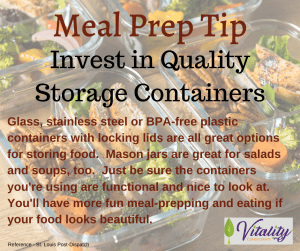 Prepare your meals in advance. If you have a few hours free during the week or over the weekend, use that time to prepare your meals in advance. Grill multiple chicken breasts, prepare salads, boil eggs, cut vegetables, and do whatever else you can in advance. That way, when your week gets busy you will still have healthy meals available. See our blog on Making 5 Meals in 1 Hour.
Prepare your meals in advance. If you have a few hours free during the week or over the weekend, use that time to prepare your meals in advance. Grill multiple chicken breasts, prepare salads, boil eggs, cut vegetables, and do whatever else you can in advance. That way, when your week gets busy you will still have healthy meals available. See our blog on Making 5 Meals in 1 Hour.- Make popsicles. Summer months are perfect for a cold, sweet treat. Unfortunately, many popsicles and other frozen treats have ingredients that cause inflammation. Our solution? Make your own! Blend some fresh fruit and almond milk, put them into popsicle molds, and place them in the freezer overnight or until solid.
- Second-guess your condiments. Ketchup, BBQ sauce, mayonnaise, and other condiments are something we don’t usually give much thought to. However, most of these foods usually have gluten or added sugar as a filler. Check the labels on the condiments in your refrigerator. If yours have these ingredients, look for a brand that is anti-inflammatory or make your own with our links to healthy condiment recipes!
- Add some variety to your beverages. Our bodies require a lot of water to function properly. Unfortunately, it can be difficult to drink the recommended amount. Try adding flavored Stevia to tap water, seltzer water, or club soda. Just make sure the carbonated beverages are free of added sugars and artificial sweeteners.
- Grow your own herbs. You can grow herbs in a pot in your home, on your patio, or in the ground. Their seeds can be purchased inexpensively and each plant produces much more than you can imagine. Use them fresh when you can. Before they go bad, freeze them in ice trays with olive oil. Transfer them to a plastic bag after they are frozen and use in your cooking all year.
- Eat your calcium. Dairy products can cause inflammation, making them restricted on an anti-inflammatory diet. It is important that we still get calcium in our diets to prevent osteoporosis. Food sources of calcium include almonds, kale, broccoli, molasses, salmon, figs, chia seeds, and collard greens.
- Do physical activity. It’s true that an anti-inflammatory diet reduces the risk of chronic disease. Unfortunately, that doesn’t give us a reason not to exercise. It is recommended that all adults get 150 minutes of physical activity each week.
- Know when to buy organically. Deciding when to purchase organic can be tricky! An organization called the Environmental Working Group put together a list of produce that typically contains the highest amounts of pesticides. These foods should be purchased organically whenever possible and include apples, celery, cherries, cherry tomatoes, cucumbers, grapes, nectarines, peaches, spinach, strawberries, sweet bell peppers, and tomatoes.
- Think outside the box. Use a zucchini boat instead of a taco shell to avoid the inflammatory properties of tortillas and provide your body with anti-oxidants found in the vegetable. Cut the zucchini in half and hollow it out with a spoon before filling it with ground meat, lettuce, salsa, and your other favorite toppings! See our pin on how to prepare Pulled Pork Zucchini Boats. Use this same recipe and get creative with ingredients.
- Rethink the way you prepare vegetables. Butter and salt may make your veggies taste delicious, but this is not always the best preparation method. Try adding olive oil and lemon pepper or fresh herbs to your vegetables to reduce sodium and add healthy fats to your meal.
- Use social media as a tool. Over the years, social media’s impact on our lives has grown. Why not use it to your advantage? Follow pages that support the anti-inflammatory lifestyle, share great recipes, post photos of your favorite dishes, and share your success with others. You can follow our Pinterest page or join our private Anti-Inflammatory Recipe Exchange Facebook group.
- Choose your booze wisely. Unless you have celiac disease, most liquors are allowed under anti-inflammatory guidelines because the distillation process removes the majority of gluten from the product. Make sure your mixers are low-calorie and do not contain added sugars. Good options include unsweetened tea, 100% fruit juice, or club soda. If this isn’t enough variety for you, use SweetLeaf Stevia drops mixed with seltzer water.
- But also, drink in moderation. Just because alcohol is allowed under anti-inflammatory guidelines does not mean that you should be drinking large amounts of it. Not only does alcohol contain calories, but it may lead to over-consumption of poor food choices.
- Join a class. It can be difficult to stay on track with an exercise program. Keep yourself excited to workout by joining a group fitness class such as kickboxing, water aerobics, Zumba, or yoga.
- Keep frozen meals on hand. It’s no secret that life often gets in the way of our good intentions. Don’t let your busy schedule keep you from a healthy lifestyle. Keep a few healthy meals in your freezer so that you can stick to your diet even on the craziest of days. Here are some Tips on Freezable Foods.
- Question yourself. There are many reasons that we go to grab a snack. Sometimes we are bored, stressed, or just have a desire to eat. Before you take a bite, ask yourself why you are eating. Are you hungry? Or is your snacking just impulsive? If you find that you’re not actually hungry, opt for a glass of water, iced tea, or seltzer water.
- Fruit is nature’s dessert. We often think of fruit as only a snack item. Don’t forget that flavors can be manipulated to make a delicious dessert. Try cutting up a peach, topping it with chopped almonds, and putting it in the oven until golden-brown. Or slice an apple, top with cinnamon, and microwave for 45-seconds.
- Bring your lunch. OK, this may make you feel like you’re taking a trip back to high school, but studies have shown that people who eat their lunch out of the office eat more calories and fat than those who bring their lunch.
 Stay hydrated. Water is an important part of your diet! It helps regulate your body temperature, flush out toxins, lubricate joints, and is a component of blood. Drinking enough water will ensure these functions are working, and will even fill you up (which may prevent over-eating).
Stay hydrated. Water is an important part of your diet! It helps regulate your body temperature, flush out toxins, lubricate joints, and is a component of blood. Drinking enough water will ensure these functions are working, and will even fill you up (which may prevent over-eating).- Focus on what you CAN have. Turns out there are a lot of foods that cause inflammation, which makes an anti-inflammatory diet seem pretty restrictive. Instead of focusing on what you can’t have, focus on what you can have. Make a list of your favorite foods that are part of an anti-inflammatory diet and eat them frequently. See
- Make a list. Think about what your favorite anti-inflammatory dishes are. Got them? Write them down and put your list somewhere that can easily be found. Make these foods regularly! When you eat your favorite meals you feel satisfied, which can make you realize that this is not just a diet, but a lifestyle change.
- Go to the farmer’s market. There are many benefits of shopping at the farmer’s market including: A) You get to meet the people growing your food – some farmers will give discounts to loyal customers. B) The prices are great. C) You know your food is fresh. D) It’s FUN. E) You may end up eating food you never would have thought to buy before.
- Buy a new cookbook. There’s a little bit of excitement that comes with getting something new, especially a cookbook. Try new recipes, get some insight from the author, and enjoy a delicious meal you’ve never had before. Buy Ashley Nanney’s “30-Day Anti-Inflammatory Challenge” cookbook on Amazon for 30 days of fabulous recipes.
- Host a dinner party. Going out with friends can be difficult, especially when you are sitting with someone who is not as dedicated to their health as you. Instead of going out, have your friends come over for dinner. Make your favorite anti-inflammatory meal and dessert!
- Utilize marinades. Marinating your food can be a simple way to add great flavors to a dish. One idea? Marinate diced chicken in a mixture of dijon mustard, lemon juice, thyme, salt, and pepper. Put the chicken on skewers with vegetables and put them on the grill.
- Catch some zzz’s. Lack of sleep is associated with hunger and weight gain. When we don’t get enough sleep, our hunger hormones get off-balanced. The hormone that makes us feel hungry is increased by as much as 15%, while the hormone that makes us feel satisfied is decreased by 15%.
- Don’t make it difficult. You can do things the hard way or the easy way. You have enough going on in your life – your food should be one of the easy things. Don’t spend time counting your calories or grams of fat. Instead, focus on what foods you are consuming. Strive to eat a variety of colorful, nutritious food.
- Don’t use food as a reward. You absolutely need to recognize your accomplishments in life – big and small. Just use rewards other than food. Using food as a reward may be a trigger for overeating or making poor choices. Try treating yourself to a movie, going on a trip, or visiting a park with a loved one instead.
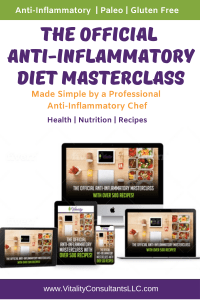 Know your s***. Ok, so you follow an anti-inflammatory diet. Great job! Do you know why you eliminated grains, soy, dairy, corn, beans, and refined sugar? If not, you have some research to do! To be successful, you need to know what these foods can do to you and why you shouldn’t go back to eating them. The Official Anti-Inflammatory Diet Masterclass is the perfect place to get this information, anti-inflammatory diet tips PLUS over 500 anti-inflammatory recipes that were created and tested by a professional anti-inflammatory chef.
Know your s***. Ok, so you follow an anti-inflammatory diet. Great job! Do you know why you eliminated grains, soy, dairy, corn, beans, and refined sugar? If not, you have some research to do! To be successful, you need to know what these foods can do to you and why you shouldn’t go back to eating them. The Official Anti-Inflammatory Diet Masterclass is the perfect place to get this information, anti-inflammatory diet tips PLUS over 500 anti-inflammatory recipes that were created and tested by a professional anti-inflammatory chef.- It’s ok to adjust the diet. The purpose of the anti-inflammatory diet is to decrease inflammation throughout your body. It actually does a phenomenal job of doing so. However, it isn’t an all or nothing approach. If you simply can’t live without peanut butter, cheese, or sweet n low, that’s ok. Incorporate small amounts of these foods, but stay true to the rest of the guidelines.
- Be realistic. Don’t set unreasonable expectations for yourself. Just like you won’t gain 5 pounds overnight, you won’t lose them either. Unfortunately, it’s going to take some time to see results. If you are expecting weight loss and don’t see it right away, don’t beat yourself up.
- Tomorrow is a new day. Slip-ups are inevitable. Don’t beat yourself up over it. Remember that just like one great meal won’t make you thin, one bad meal won’t make you fat. Remember to drink water to help your body flush out toxins and get back on track as soon as possible.
- Find accountability. There are many ways to be held accountable for following through on your lifestyle plans. You can keep a food journal, enroll a friend or family member to ask about your progress, or join an online support group. Whatever your method, make sure you are held accountable for following through with your plans.
- Don’t deprive yourself. One of the signs that your diet is going to be successful is that is can adapt to your life. If you are constantly feeling deprived of your favorite foods, the likelihood of being able to follow anti-inflammatory guidelines for life is very small. To be more successful, try the 80/20 rule or personalize the guidelines to fit your needs.
- Eat more! Yep, you can EAT MORE while being on a diet. You can download a FREE anti-inflammatory foods list but these are the top 10 anti-inflammatory foods that you should eat the most include:
- Almonds
- Blueberries
- Broccoli
- Brussels sprouts
- Flaxseed
- Green tea
- Herbs and spices
- Mushrooms
- Onions
- Salmon
Do you have any other tricks that keep you on track? Share with us any of your anti-inflammatory diet tips or tricks.
Our list of Anti-Inflammatory Diet Tips included #4 which was to Try new recipes. Here is an anti-inflammatory recipe to get you started.
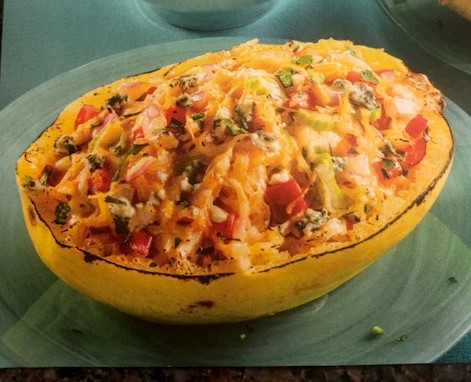
Buffalo Chicken Stuffed Spaghetti Squash
Ingredients
- 2 spaghetti squash halved and seeded
- 2 cups cooked and shredded chicken breasts
- ½ red onion chopped
- ¼ cup sliced green onion
- 1 red bell pepper seeded and diced
- 3 celery stalks chopped
- ¾ cup shredded Cheddar Jack cheese divided (Keto option)
- ½ cup plain Greek or coconut yogurt
- ½ cup Frank's HotSauce
- Salt and pepper to taste
- ⅓ cup blue cheese crumbles Keto option
- 2 Tbsp chopped fresh parsley for garnish
- Non-stick cooking spray
Instructions
- Preheat oven to 400°F and line a sheet pan with foil and spray with cooking spray.
- Place squash cut-side down on sheet pan. Cook about 35-45 minutes or until fork tender.
- In a large bowl, combine chicken, onion, green onion, bell pepper, celery, 1/2 cup cheese (Keto option), yogurt and hot sauce.
- Reduce oven heat to 350°F. Using a fork, scrape squash out of shells and stir into bowl with chicken mixture. Season with salt and pepper to taste. Divide filling among shells. Top with remaining Cheddar Jack and blue cheese (Keto option).
- Return squash to oven and bake until filling is warmed through, about 15-20 minutes. Top with parsley if desired.
#makealist, #getsomezzzzs, #bemindful, #30DayAntiInflammatoryChallenge, #popsicles:)
If you’re interested in an anti-inflammatory lifestyle and more information (and recipes) like this, check out The Official Anti-Inflammatory Diet Masterclass. Or email us at info@VitalityConsultantsLLC.com for more details.



